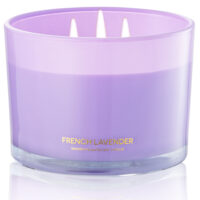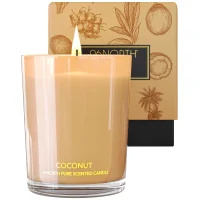Soy – it’s in everything these days. From soy milk to soy sauce, this versatile ingredient is used in a variety of different foods and products. So it should come as no surprise that soy wax is also becoming a popular choice for candles. In this article, we’ll dive into the topic of soy candles in detail by explaining how they work and answering some common questions about them. We’ll also explore some of the benefits of soy candles over regular paraffin candles. So if you’re curious about this growing trend, read on!
Key Points
- Soy candles are a newer alternative to traditional paraffin candles
- Soy candles are made from soybeans, a renewable resource
- There are several differences to be noted between soy-based and regular candles
- Deciding what candle wax is right for you will come down to your preferences and appreciation of the pros and cons of each type
Soy Candles Defined and Explained
Let’s start off by getting familiar with the subject matter at hand here – soy candles. In short, soy candles are candles that are made with soy wax instead of the more traditional paraffin wax. But what exactly is soy wax? How is it used for candles? And what makes it unique?
All About Soy Wax
Soy wax is a type of vegetable wax derived from soybeans. It is a 100% natural product and
free of additives like stearic acid, polymer, polyethylene and microcrystalline.
The process of creating soy wax starts with the harvesting of soybeans. They’re picked, cleaned, cracked, de-hulled and rolled into flakes, then undergo a process called ‘hydrogenation’.
Hydrogenation is a chemical reaction that occurs when hydrogen is added to a liquid element or compound. It’s commonly used in the manufacturing sector to solidify, preserve or purify raw materials and can be done using either a catalyst or high pressure environment.
In the context of soy products, hydrogenation converts some of the fatty acids found in soybean oil from an unsaturated to saturated state, dramatically altering its melting point and allowing it to remain solid at room temperature.
Soy wax can be used in a number of ways; it’s frequently added to skin care products like lotions and creams, used as a food additive, and of course, is the main ingredient in soy candles.
How Soy Candles are Made
Soy wax candles are most commonly made by established candle makers, though there are plenty of DIY recipes available online if you’re feeling creative.
The process is fairly simple:
1. Melting and Mixing
When making soy wax candles, the first step is to melt the wax. This is usually done in a large pot or boiler, over a low heat. Once melted, the wax is combined with fragrance oils and colourants. The desired fragrance and colour combination is added to the melted wax and stirred until evenly mixed.
2. Pouring and Wicking
The next step is to pour the wax mixture into candle moulds. The moulds can be made of metal, glass, ceramic or silicone and come in a variety of shapes and sizes. Once the wax has been poured into the mould, a wick is placed in the centre of each candle. The wicks are generally made of cotton or another natural fibre and are coated in a thin layer of soy wax to help them stand upright in the centre of the candle.
3. Cooling
The final step is to allow the candles to cool and solidify. This can take several hours, depending on the size of the candle. After the wax has cooled and solidified, the candle is trimmed and ready to be used.
Soy Wax Candles vs Regular Candles
Soy-based candles and regular wax candles perform the same function yet each have characteristics very unique from one another. The following is a breakdown of some of the most noteworthy differences between the two and what they mean in terms of the final product’s performance.
Slightly Different Manufacturing Process
The process of making soy wax candles is largely the same as regular candle making, with a few key differences.
The first is that soy wax has a lower melting point than other types of candle wax, which means it can be melted using a double boiler or crockpot instead of a traditional wax melter.
The second difference is in the fragrance oils used. Soy wax candles are often scented with essential oils, which are natural extracts from plants. This gives them a more subtle scent than candles made with synthetic fragrance oils.
The third difference is in the wicking. Because soy wax has a lower melting point, it can be difficult to get the wick to stay lit. As a result, many soy candle makers use wicks made of cotton or another natural fibre that are coated in a thin layer of soy wax. This helps the wick to stay lit and prevents it from drowning in the melted wax.
Different Look and Feel
Soy candles also have a different look and feel than regular wax candles. They are usually opaque or semi-opaque and are known for often having a bumpy or cratered surface after burning, which is caused by the lower melting point of the wax.
They also often have a softer, more velvety feel than regular candles because of the way soybean oil is processed.
Different Burning Characteristics
Soy wax candles and regular candles also have different burning characteristics. Soy wax candles typically have a slow burn time, meaning they will last longer than a regular candle. They also have a lower melting point, which means they will not get as hot when burned. This makes them safer to use around children and pets.
Soy wax candles also tend to produce less soot than regular candles. When burned, soy wax candles release negative ions into the air, which are known to help purify the air and remove toxins.
Unique Care Needs
Soy wax candles require a bit of special care to ensure they last. Because they have a lower melting point, they should be kept away from heat sources and out of direct sunlight when not lit, as well as handled more gently when hot.
Soy wax candles should also be burned for a longer period of time the first time you use them, to ensure the entire wax melt pool is used. This will help to prevent the formation of tunnels.
Different Prices
Soy wax candles are usually more expensive than regular candles because they are made with natural ingredients and require more time and effort to produce. However, many people feel that the benefits of soy wax candles are worth the extra cost.
Are Soy Candles Better Than Regular Candles?
Now onto the burning question (no pun intended): Are soy candles better than regular candles? The answer, like most things, is that it depends.
Both soy wax candles and regular candles have their own unique advantages and disadvantages. It really comes down to personal preference in the end.
Some people prefer soy candles because they are made with natural ingredients, burn slower, and produce less soot. Others prefer regular candles because they are usually cheaper and have a more traditional look and feel.
If you’re in the market and are wondering what might make an alternative product like soy-based candles better for your needs, learning a little more about their benefits may just help make your decision easier. Consider some of the following pros:
Softer Light
There’s a common rule to know when it comes to candle wax: the higher its melting point, the brighter it will burn. As such, the light produced by a soy candle is often said to be softer and more pleasant than the light given off by a regular candle. This can be beneficial for those who want to set a certain mood in their home without the harshness of a typical light bulb.
Stronger Aroma
When you want your candles to give off a strong and pleasant smell, it’s often soy-based varieties that will do the job best. The lower melting point of soy allows it to hold fragrance oils better, meaning that the scent will be released more readily and be more potent. This can be ideal for people who want to use candles for aromatherapy purposes or simply enjoy having their home smelling great.
Longer Lasting
When burned correctly, soy candles typically last around 30-50% longer than regular paraffin candles. That’s a significant difference that may save you money in the long run, especially if you’re the type of person who burns candles often.
Environmentally Friendly
Soybeans are a renewable resource, which means that soy candles are biodegradable and generally considered to be more environmentally friendly than regular candles.
Cleaner Burning
When burned, soy candles produce little to no soot. This is in contrast to regular candles which often produce a fair amount of soot. Not only is this soot unsightly, but it can also be harmful to your lungs if inhaled.
Final Thoughts
If you’re still not sure if soy candles are right for you, the best way to find out is to try them for yourself. Head to our online store to check out our selection of soy candles in a variety of scents. We’re sure you’ll find one that you love!
FAQs
Any looming questions? Get answers to some of the most common queries about soy candles below.
What is the difference between soy and regular candles?
Soy candles are made with natural soybean wax, while regular candles are typically made with paraffin wax. Soy candles burn slower and produce less soot than regular candles.
Do soy wax candles break easily?
Because soy wax candles are made with natural ingredients, they may be more susceptible to temperature changes and may break more easily if exposed to extreme heat or cold. However, if you take proper care of your soy candles, they should last just as long (if not longer) when compared to regular candles.
What is the best way to store soy candles?
Soy candles should be stored in a cool, dry place. Avoid exposure to extreme heat or cold, as this can cause the soy wax to break down.
Do soy candles produce a lot of smoke?
Soy candles produce very little to no smoke when burned correctly. This is in contrast to regular candles, which often produce a fair amount of soot.









